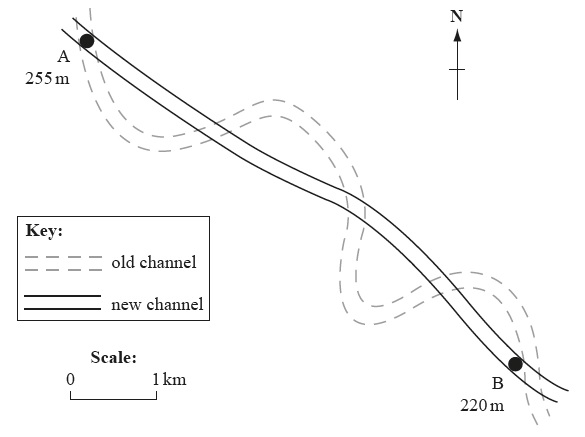| Date | November 2013 | Marks available | 8 | Reference code | 13N.2.sl.1 |
| Level | SL only | Paper | 2 | Time zone | |
| Command term | Explain and State | Question number | 1 | Adapted from | N/A |
Question
The diagram shows the changes in a river channel following implementation of a management strategy.

Define the term stream discharge.
(i) State the direction towards which the river is flowing at B.
(ii) State three changes to the river channel that result from this management strategy.
(iii) Explain one benefit and one problem for people that might result from this management strategy.
Examine the benefits and problems of different river management strategies (other than that shown in the diagram).
Markscheme
The volume/amount of water [1 mark], passing a given point in a given time [1 mark]. Or also accept formula of velocity × cross-sectional area.
(i) South East.
(ii) The new channel is straighter [1 mark], shorter [1 mark], and has a steeper gradient [1 mark].
Accept changes to processes, such as more erosion [1 mark].
(iii) Benefits: better for navigation due to shortening of the channel, flood water removed more quickly.
Problems: flood moves faster downstream, flood is larger downstream, lag time downstream is reduced, navigation upstream is harder, erosive power of the river is increased.
Award [1 mark] for each correct statement and a further [1 mark] for a valid explanation.
Candidates should refer to at least two different strategies. (No credit should be given for strategies that look at channel straightening.)
The following approaches may be relevant:
- multi-purpose schemes (dams) that have flood control dimensions
- hard engineering approaches including levees, diversion channels, spreading grounds, walls, flood relief channels
- other approaches to stream management including river restoration schemes (restoring natural surfaces, channel shape, habitats); water quality legislation and actions (for example, nitrate control); wetland restoration.
Also accept drainage basin schemes that impact on river processes or water quality, for example, afforestation; river hazard management schemes, for example, land-use zoning that leaves unoccupied areas for river to occupy during flood.
The use of only one river management strategy which includes benefits and problems is unlikely to progress beyond the D/E border.
To achieve band E there must be an attempt at evaluation of two strategies. At band F expect a well balanced evaluation.
Marks should be allocated according to the markbands.

